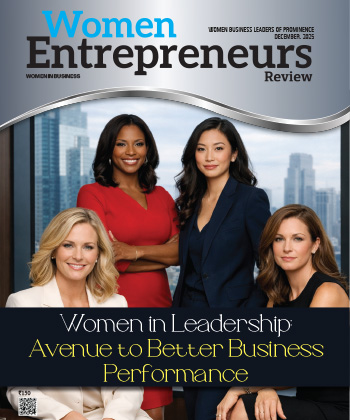
Incorporating Sustainability in the Furniture Industry to Attract New-Age Consumers
By: Padma Gupta, Director - HR, Customer Experience & Strategy, Hafele India
Padma is an HR and CSR specialist with prior experience across different industries such as oil & gas, manufacturing, building material, and engineering. She has been with Hafele India for nearly 13 years where she takes care of human resources, training, customer experience, and strategy.
In an extensive conversation with Women Entrepreneurs Review, Padma discusses ESG initiatives in the furniture industry. She underscores the need for collaboration among teams to effectively address ESG and the top management’s role in building a culture of responsibility. Read out her expert HR perspective on driving ESG efforts.
How do you see the current market dynamics in the furniture industry influencing the prioritization of CSR and ESG initiatives? Are there specific trends that you believe HR leaders should strategically leverage to drive sustainable value creation?
The furniture industry is highly consumer-oriented, with a growing focus on younger, environmentally-conscious consumers. Topics like global warming and sustainability are important to them. A Nielsen study found that 73% of millennials are more willing to pay for sustainable goods, indicating a shift towards sustainability and responsible consumption patterns.
Traditionally, the Indian furniture market emphasized craftsmanship, aesthetics, and durability, with less focus on sustainability. However, there is now a significant shift towards sustainable furniture and products, and a greater emphasis on the circular economy, which promotes managing the entire product lifecycle for longevity and repairability. The "use and throw" culture, which caused environmental harm, is being replaced by sustainable practices.
The furniture industry is increasingly adopting sustainable methodologies, building sustainable value systems within organizations, and partnering with vendors to address environmental concerns. The industry is also active in Corporate Social Responsibility (CSR), demonstrating responsibility towards the ecosystem and society.
The industry is rapidly transitioning from traditional practices to compliance with Environmental, Social, and Governance (ESG) initiatives, driven by both government regulations and consumer demand. ESG compliance is becoming increasingly important. As HR professionals, it's crucial to be aware of these developments and the regulatory changes.
HR's role involves staying informed about these changes, educating employees on new practices, and integrating these values into the organization’s goals, hiring practices, and vision. HR can be a key driver in ensuring that the organization becomes socially responsible and environmentally conscious.
With the rising demand for sustainable and ethically produced furniture, how can HR leaders balance customer expectations with the company’s ESG commitments, particularly in terms of talent acquisition, retention, and customer experience strategy?
When we look at sustainability and environmental consciousness, we measure specific aspects such as carbon emissions, plastic usage, and community engagement. Our customers are increasingly aware of these factors, so as HR leaders, we are focused on driving initiatives to make our operations more responsible. This includes reducing plastic usage in our organization and packaging materials, sourcing environment-friendly products, and ensuring that our partners and vendors adhere to human rights, diversity initiatives, and the prohibition of child labor.
In the building material industry, for example, we focus on surfaces and products that are easy to clean, do not emit harmful substances, and are environmentally friendly. These goals are integral to our team's daily operations and have a direct impact on customer satisfaction.
Customer experience is a bit more complex. As HR or the technical training head, we conduct a lot of training for customers. While customers appreciate physical meetings, traveling increases carbon emissions and fuel usage. Therefore, we've strongly adopted technology in customer experience, using it for training, product demonstrations, and query resolutions, particularly for appliances and digital locks. Instead of sending technicians physically, we provide digital experiences through our call center, using video and audio-visual means to deliver the same level of service while reducing our environmental footprint.
We've also eliminated plastic bottles, opting for filtered water, and though these are small initiatives, they contribute significantly to balancing customer expectations with our environmental goals. Reports indicate that customers are willing to spend more on environmentally friendly products. We have a robust after-sales service, repair, and recycling policy, taking back non-usable appliances and materials and working with NGOs to dispose of them responsibly. This is how we, as an organization, maintain a balance between customer experience and environmental responsibility.
In your opinion, how can HR leaders foster cross-functional collaboration to amplify the impact of ESG initiatives? What role do partnerships with external stakeholders (e.g., suppliers, NGOs) play in this, and how can HR strategically manage these relationships?
To effectively address ESG, collaboration across teams is essential. HR alone cannot create the necessary impact. Key stakeholders include finance and legal teams, who bring knowledge of the legal regulatory framework, and risk mitigation teams, who analyze potential risks to people or the environment. Strategy teams are crucial for establishing the governance model within the ESG framework, while HR, admin, facilities, and supply chain teams ensure that sustainability efforts are integrated throughout the organization.
For example, we offer water-saving faucets with auto-off mechanisms, reflecting our commitment to intelligent product creation that promotes reduction, reuse, and recycling. Our process management team ensures these initiatives are built into the KRAs and KPIs of all relevant teams. From our head office in Germany to department heads and their teams, sustainability is a clear organizational goal. HR plays a pivotal role in ensuring this goal is actionable by tying rewards, appraisals, and measurable indices like electricity usage, water consumption, and carbon footprint to these initiatives. This approach ensures that all functions work together towards our common goal of sustainability.
How can HR leaders navigate the intersection of company culture and sustainability? What are some of the challenges and opportunities in ensuring that sustainability becomes a deeply embedded aspect of the organizational culture?
In an organization, culture flows from the top. Leaders must create this culture, particularly in areas like reducing the carbon footprint by optimizing travel and leveraging technology and collaboration. Outsourcing certain activities can also help minimize carbon footprints. This directive must come from the top to ensure that product managers prioritize environmentally friendly products and are motivated, encouraged, and rewarded for doing so. Similarly, marketing teams should be encouraged to use eco-friendly promotional materials.
When top management actively promotes these values, the entire organization becomes oriented towards sustainability. Additionally, partnering with external stakeholders, such as suppliers, NGOs, franchisees, and dealer partners, allows the organization to influence the industry and create a circular economy focused on reuse, reduce, and recycle.
Training and education on these topics should become as standard as sexual harassment prevention training is today. If HR professionals and organizations embrace education on environmental, ESG, and CSR topics, these practices will become the new normal in the coming years. Just as certain behaviors are not tolerated within organizations due to company culture and governance, integrating rules, policies, and values will drive real change in society.
How do you envision HR’s role in future-proofing the workforce by embedding sustainable practices into learning and development programs?
HR plays a role throughout the entire employee life cycle. The first step is hiring socially conscious individuals who are aware of ESG practices or at least have a strong intent. Once talent is onboarded, it's crucial to integrate ESG elements into learning and development practices. For example, Hafele's Business Excellence Team drives the DERA challenge, where the MD encourages all employees to contribute sustainability ideas, with rewards for the best ones. This fosters a culture of environmental consciousness and future-proofs the workforce by shifting the mindset of current employees.
Additionally, HR can integrate ESG practices into performance appraisals, measuring progress in this area. Transparent progress tracking, such as monitoring and sharing data on water and electricity consumption, can also drive accountability. When employees see this information, they're more likely to take action to reduce consumption. Educating employees on ESG commitments and making them partners in these efforts helps build a socially conscious organization. My role in HR and as a management team member is to help create workforces that naturally align with these practices.
Messages For Leaders
One important message I want to convey is that when it comes to ESG or social responsibility, size doesn't matter—intent does. Entrepreneurs often delay these efforts, thinking they’ll address them when they grow bigger. But if they incorporate these principles from the start, while creating systems, organizations, and innovative products, it can set the foundation for lasting impact. India is a unicorn country, with an unmatched number of startups. If all entrepreneurs were conscious of their environmental and social responsibilities from the beginning, India would be a much better place. Start small, and as you grow, these initiatives will naturally expand and become more effective.
Most Viewed
- 1 Women's Health Startup HerMD Closing Doors Amid Industry Challenges
- 2 5 Famous Women in Indian Armed Forces
- 3 Saudi Women No longer Require Male Permission for Clothing Choices, says Prince MbS
- 4 Kolkata Medtech Startup Innovodigm Raises Rs 5.5 Crore Seed Funding Led by IAN Group
- 5 Yamunanagar's Kashish Kalra Honoured after Securing 111th Rank in UPSC Civil Services Exam
- 6 Madurai Appoints Its First Woman Corporation Head
- 7 IAS Vijayalakshmi Bidari Appointed as the new Nagpur Divisional Commissioner
- 8 American Entrepreneur Lucy Guo Overtakes T Swift to become Youngest Female Billionaire
- 9 ICC Women's World Cup 2025 Trophy Showcased at Indore's Holkar Stadium
- 10 Aparna Saxena's Beauty Venture AntiNorm Launches in India
- 11 Vidya Nataraj Co-Founded BlueStone Jewellery & Lifestyle files IPO
- 12 5 Women Freedom Fighters of India
- 13 Dr. G Krishnapriya appointed as CEO for Trichy
- 14 M3M & Sirona Partner to Introduce Menstrual Hygiene Vending Machines in 15 Locations
- 15 Punjab Govt launches SHE Cohort 3.0 Supporting Tech-led Women Startups
- 16 Indian origin Lawyer, Sweena Pannu appointed as the US New Superior Court Judge
- 17 The Aurora Tech Award recognizes 4 Indian Women-led Startups
- 18 Kerala's Republic Day parade featured an all-female tableau
- 19 Manisha Kabbur Becomes Karnataka's First Woman International Karate Coach
- 20 Director K. S. Ravikumar's Daughter Maalica Ravikumar Launches Life Coaching Company 'Evergrowth Academy' for Women
- 21 Leezu's Raises Pre-Seed Funding to Accelerate Growth in Sexual Wellness Industry
- 22 Sattu: Super-easy summer drink for PCOS gut healing
- 23 Swathi Nelabhatla creates Sitha App, India's First Women-Exclusive Gig Platform
- 24 7 Timeless Female Kathak Dancers & their Iconic Legacies
- 25 Meet 7 Iconic Women Architects of Modern India & their Most Impactful Work
- 26 This Woman-led Insuretech Startup is Helping Bridge the Education Financing Gap in India
- 27 Women Leaders Share Lessons Learnt from India Women's WC Win
- 28 5 Enterprising Women Founders Powering Singapore's Tech & Innovation Landscape
- 29 4 Women. 4 Stories. One Vision for Smarter, Stronger Healthcare
- 30 Global Gender Gap Narrows to 68.8%, But Full Equality 123 Years Away: WEF Report 2025
- 31 Changemakers: 7 Women Entrepreneurs Taking the Make in India Movement Forward
- 32 Meet Lucy Guo, The Youngest Self-Made Female Billionaire Disrupting Tech
- 33 How Women are Driving India's Festive Online Shopping Surge






